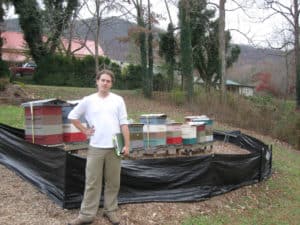
Product certification is a process designed to give some level of assurance to consumers that a product is produced under certain guidelines. In honey bees, we tend to most often think about USDA Organic certification of honey. However, there are other certification programs in honey bees including Certified Naturally Grown (CNG) and queens produced by the Russian Honeybee Breeders Association.
I was recently asked to inspect a new Certified Naturally Grown apiary to provide confirmation that the beekeeper was following their definition of a “natural” product, defined mostly by the absence of “any synthetic herbicides, pesticides, fertilizers, antibiotics, hormones, or genetically modified organisms”. The guidelines include more than that, but you get the idea. This got me thinking about certified production in general (an intriguing subject to me), so I agreed to participate and help Aaron and Kellie Burns of the Burns and the Bees Apiary get started with CNG.
Why certify a product?
As difficult as agriculture is as an industry, why would any producer want to apply more constraints to their operation, especially in beekeeping? I think the reason is communication. If you want to quickly communicate to a consumer some information about how your products are produced, certified production might be for you. Its kind of like reputation building. People more and more want to know where their food comes from and how it is produced. By certifying a product, you might build a consumer’s confidence that you do what they want.
Confidence in certification programs

Although a product is certified, there are no guarantees that rules where genuinely followed to the letter of their intent. However, in a good certification program, a process should be established that gives an average person confidence in the certified label. Certified Naturally Grown includes in their system, inspection by other beekeepers that can verify that the beekeeper appears to be following the guidelines. Record keeping is another common, important theme in certified programs. As part of the inspection, I reviewed the paper trail Aaron has created from management notes like monitoring for varroa mites. There is also a process of networking and long term communication that increases my ability to confidently say that the Burns are clearly following Certified Naturally Grown guidelines.
Conveying a clear message
In my opinion, Certified Naturally Grown has done an excellent job in making their definition of naturally grown honey clear and easily understandable by both producers and consumers. All the rules, forms, and procedures are easy to navigate to on the CNG website. The same thing can’t be said for USDA Organic honey. USDA Organic honey certification relies more on the certifying agencies application of recommendations made by the National Organic Standards Board (NOSB) (updated in 2010). One could argue that this flexibility is a good thing, since this may allow the certifying agent to consider the specifics of the producer or the honey processor or trader. However, I think the obscurity of the definition of organic honey is one reason we see so few organic honey labels on store shelves. Within CNG, you might argue if specific rules really lend themselves to natural production, like the amount of sun a colony receives, however one thing that would be difficult to argue is the clarity of what they define as “naturally grown”.